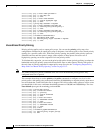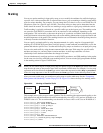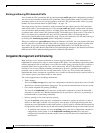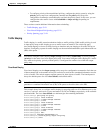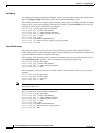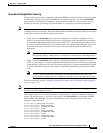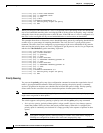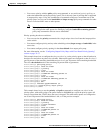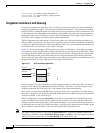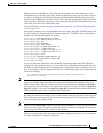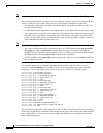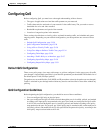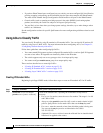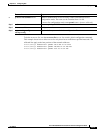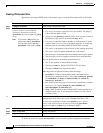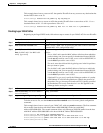
33-26
Cisco ME 3400 Ethernet Access Switch Software Configuration Guide
OL-9639-06
Chapter 33 Configuring QoS
Understanding QoS
Switch(config)# interface gigabitethernet 0/1
Switch(config-if)# service-policy output policy1
Switch(config-if)# exit
Congestion Avoidance and Queuing
Congestion avoidance uses algorithms such as tail drop to control the number of packets entering the
queuing and scheduling stage to avoid congestion and network bottlenecks. The switch uses weighted
tail drop (WTD) to manage the queue sizes and provide a drop precedence for traffic classifications. You
set the queue size limits depending on the markings of the packets in the queue. Each packet that travels
through the switch can be assigned to a specific queue and threshold. For example, specific DSCP or
CoS values can be mapped to a specific egress queue and threshold.
WTD is implemented on traffic queues to manage the queue size and to provide drop precedences for
different traffic classifications. As a frame enters a particular queue, WTD uses the packet classification
to subject it to different thresholds. If the total destination queue size is greater than the threshold of any
reclassified traffic, the next frame of that traffic is dropped.
Figure 33-7 shows an example of WTD operating on a queue of 1000 frames. Three drop percentages
are configured: 40 percent (400 frames), 60 percent (600 frames), and 100 percent (1000 frames). These
percentages mean that traffic reclassified to the 40-percent threshold is dropped when the queue depth
exceeds 400 frames, traffic reclassified to 60 percent is dropped when the queue depth exceeds 600
frames, and traffic up to 400 frames can be queued at the 40-percent threshold, up to 600 frames at the
60-percent threshold, and up to 1000 frames at the 100-percent threshold.
Figure 33-7 WTD and Queue Operation
In this example, CoS values 6 and 7 have a greater importance than the other CoS values, and they are
assigned to the 100-percent drop threshold (queue-full state). CoS values 4 and 5 are assigned to the
60-percent threshold, and CoS values 0 to 3 are assigned to the 40-percent threshold.
If the queue is already filled with 600 frames, and a new frame arrives containing CoS values 4 and 5,
the frame is subjected to the 60-percent threshold. When this frame is added to the queue, the threshold
would be exceeded, so the switch drops it.
WTD is configured by using the queue-limit policy-map class command. The command adjusts the
queue size (buffer size) associated with a particular class of traffic. You specify the threshold as the
number of packets, where each packet is a fixed unit of 256 bytes. You can specify different queue sizes
for different classes of traffic (CoS, DSCP, precedence, or QoS group) in the same queue. Setting a queue
limit establishes a drop threshold for the associated traffic when congestion occurs.
Note You cannot configure queue size by using the queue-limit policy map class command without first
configuring a scheduling action (bandwidth, shape average, or priority). The only exception to this is
when you configure queue-limit for the class-default of an output policy map.
CoS 6-7
100%
60%
40%
1000
600
400
0
CoS 4-5
CoS 0-3
86692



